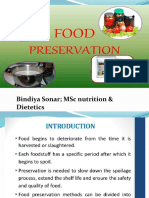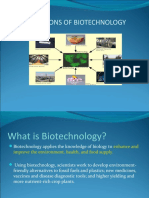0 ratings0% found this document useful (0 votes)
17 viewsLecture 2
The document discusses food preservation techniques, focusing on thermal preservation methods. It explains objectives of preservation, principles of preservation by heat, types of thermal processing including blanching, pasteurization and sterilization. Factors affecting heat resistance of microorganisms are also covered.
Uploaded by
abdisa767Copyright
© © All Rights Reserved
Available Formats
Download as PDF, TXT or read online on Scribd
0 ratings0% found this document useful (0 votes)
17 viewsLecture 2
The document discusses food preservation techniques, focusing on thermal preservation methods. It explains objectives of preservation, principles of preservation by heat, types of thermal processing including blanching, pasteurization and sterilization. Factors affecting heat resistance of microorganisms are also covered.
Uploaded by
abdisa767Copyright
© © All Rights Reserved
Available Formats
Download as PDF, TXT or read online on Scribd
You are on page 1/ 17
FOOD PRESERVATION & PACKAGING
TECHNOLOGY
Lecture Two
By: Shewarega Habtamu
Chapter 2
Food Preservation Techniques
(1/3)
Learning Objectives
• At the end of this Lecture, students should be able to:-
a) Explain the objectives and principles of Food
preservation.
b) Differentiate between thermal food preservation
techniques
c) Understand Factors Affecting Heat Resistance Of
Microorganisms
1. What is food preservation?
• Preservation is a method of giving some additional treatment to
different food items
• to stop or slow down the food spoilages,
• maintain quality, edibility, nutritional value and
• improving shelf-life of products.
Objectives of food preservation
1.1 Principle of Food preservation
• Prevents microbial decomposition
• Prevents self-decomposition of foods items
• By inactivating food enzymes
• Prevent oxidation reaction
• Prevents physical, chemical and mechanical damage
1.2 Methods of food preservation
• Physical methods- drying, chilling, freezing, smoking, canning,
pasteurization, Sterilization……
• Chemical methods-salting, pickling, sugaring, anti-oxidants, anti-
microbials
• Hurdle technology- Combination of
more than one preservation
techniques.
2. PRINCIPLES OF FOOD PRESERVATION BY HEAT
• Thermal processing is defined as the combination of
temperature and time required to:
• The destruction of microorganisms.
• Reduce or destroy enzyme activity
• Produce physical or chemical changes
• Make the food meet a certain quality standard
Cont’d
• The specific treatment varies with:
I. The organisms that has to be killed.
II. The nature of the food to be preserved and
III.Other means of preservation that may be used in addition to
high temperature.
2.1 Types of Thermal Processing
• Three main temperatures categories used for thermal
preservation are:
✓Pasteurization temperature – below 100℃
✓Blanching-Heating at about 100 ℃ and
✓Sterilization temperature above 100 ℃.
a. Blanching
• The primary purpose of blanching is to destroy enzyme activity in
fruit and vegetables.
• It is not intended as a sole method of preservation, But as a pre-
treatment prior to freezing, drying and canning
• Functions of blanching include:
• Reducing surface microbial contamination
• Softening vegetable tissues to facilitate filling into containers
• Removing air from intercellular spaces prior to canning
Methods of Blanching
• Hot water blanchers
• Includes various designs which hold the food in hot water for specified time,
then moves it to a dewatering/cooling section.
• Steam blanchers
• Preferred method for foods with large cut surface areas as lower leaching
losses.
• Food material carried on a mesh belt or rotatory cylinder through a steam
atmosphere, residence time controlled by speed of the conveyor or rotation
b. Pasteurization
• kills part but not all the microorganisms present and the temperature
applied is below 100 ℃
• Used to destroy enzymes.
• The heating may be by means of steam, hot 𝑯𝟐 𝑶, dry heat or
electric currents.
• The surviving microorganisms are inhibited by low temperature (or)
some other preservative method if spoilage is to be prevented.
Cont’d
• Batch (holding) method • Continuous process
• Low-Temperature-Long-Time (HTST) • High-Temperature-Short-Time
• 63 ℃ for 30 min-milk (HTST)
• 72 ℃ for at least 15 sec
c. Sterilization
• Temperatures above 100 ℃ can only be
obtained
• by using steam pressure sterilizers such as
pressure cookers and autoclaves.
• By this method all microorganisms are
completely destroyed due to high
temperature.
• The time and temperature, necessary for
sterilization vary with the type of food.
Cont’d
• The use of heat also affects the food adversely and hence
• it is necessary to use only mild heat treatment that ensures
freedom from pathogens and
• enzyme activity and
• enhance the shelf life of the food.
2.2 Factors Affecting Heat Resistance Of
Microorganisms
• Age of cell- younger cell are less heat resistance
• Initial concentration of spore or cells- more number greater
treatment
• Previous history of the spore or cells
• The medium in which growth has occurred
• Moisture content- dry food more severe heat treatment
• pH of medium-great heat resistance at or neutral pH values.
You might also like
- Isolation and Characterization of Nucleic Acid67% (3)Isolation and Characterization of Nucleic Acid4 pages
- Food Preservation System: Istiqomah Rahmawati, S.Si., M.SiNo ratings yetFood Preservation System: Istiqomah Rahmawati, S.Si., M.Si14 pages
- Food Proccessing Technologies (with notes)No ratings yetFood Proccessing Technologies (with notes)129 pages
- Thermal Processing: Judith Jatico-Cauilan Bukidnon State UniversityNo ratings yetThermal Processing: Judith Jatico-Cauilan Bukidnon State University21 pages
- "Comprehensive Guide to Food Processing: Principles, Techniques, and Equipment"No ratings yet"Comprehensive Guide to Food Processing: Principles, Techniques, and Equipment"65 pages
- Chapter 3 Food Processing and Preservation TechNo ratings yetChapter 3 Food Processing and Preservation Tech32 pages
- Thermal Processing Techniques in Food PreservationNo ratings yetThermal Processing Techniques in Food Preservation4 pages
- Pasteurization Sterilization IrradiationNo ratings yetPasteurization Sterilization Irradiation21 pages
- Methods of Food Processing y Bernard[1]No ratings yetMethods of Food Processing y Bernard[1]46 pages
- 4 Thermal Destruction of MicroorganismsNo ratings yet4 Thermal Destruction of Microorganisms15 pages
- Preservation, Its Principles and Methods PDFNo ratings yetPreservation, Its Principles and Methods PDF45 pages
- Antoquia - Toolsequipmentsmethods of Food PreservationNo ratings yetAntoquia - Toolsequipmentsmethods of Food Preservation15 pages
- Food Preservation: FAE111: Principle of Agro Process EngineeringNo ratings yetFood Preservation: FAE111: Principle of Agro Process Engineering25 pages
- Principles of Food Processing and Preservation Upd - 231102 - 132255No ratings yetPrinciples of Food Processing and Preservation Upd - 231102 - 13225541 pages
- Parvinder Kaur-Control of Microorganisms by Physical and Chemical MethodsNo ratings yetParvinder Kaur-Control of Microorganisms by Physical and Chemical Methods18 pages
- Aspen Plus Simulation of Distillation Models1Final100% (1)Aspen Plus Simulation of Distillation Models1Final218 pages
- 2 Merz Institute Skin Laxity LU 2summary PDFNo ratings yet2 Merz Institute Skin Laxity LU 2summary PDF5 pages
- Howard Berg Reading 1 & 2 Reference Material100% (1)Howard Berg Reading 1 & 2 Reference Material19 pages
- To Study The Dose Response Curve (DRC) of Acetylcholine Using Frog Rectus Abdominis Muscle100% (2)To Study The Dose Response Curve (DRC) of Acetylcholine Using Frog Rectus Abdominis Muscle15 pages
- Gibe III - Environmental and Social Impact AssessmentNo ratings yetGibe III - Environmental and Social Impact Assessment46 pages
- Effects of Fire On Cultural Resources and Archeology100% (1)Effects of Fire On Cultural Resources and Archeology236 pages
- Phylum Bryozoa: Animals That Are Moss LikeNo ratings yetPhylum Bryozoa: Animals That Are Moss Like21 pages
- Food Preservation System: Istiqomah Rahmawati, S.Si., M.SiFood Preservation System: Istiqomah Rahmawati, S.Si., M.Si
- Thermal Processing: Judith Jatico-Cauilan Bukidnon State UniversityThermal Processing: Judith Jatico-Cauilan Bukidnon State University
- "Comprehensive Guide to Food Processing: Principles, Techniques, and Equipment""Comprehensive Guide to Food Processing: Principles, Techniques, and Equipment"
- Thermal Processing Techniques in Food PreservationThermal Processing Techniques in Food Preservation
- Antoquia - Toolsequipmentsmethods of Food PreservationAntoquia - Toolsequipmentsmethods of Food Preservation
- Food Preservation: FAE111: Principle of Agro Process EngineeringFood Preservation: FAE111: Principle of Agro Process Engineering
- Principles of Food Processing and Preservation Upd - 231102 - 132255Principles of Food Processing and Preservation Upd - 231102 - 132255
- Parvinder Kaur-Control of Microorganisms by Physical and Chemical MethodsParvinder Kaur-Control of Microorganisms by Physical and Chemical Methods
- Aspen Plus Simulation of Distillation Models1FinalAspen Plus Simulation of Distillation Models1Final
- To Study The Dose Response Curve (DRC) of Acetylcholine Using Frog Rectus Abdominis MuscleTo Study The Dose Response Curve (DRC) of Acetylcholine Using Frog Rectus Abdominis Muscle
- Gibe III - Environmental and Social Impact AssessmentGibe III - Environmental and Social Impact Assessment
- Effects of Fire On Cultural Resources and ArcheologyEffects of Fire On Cultural Resources and Archeology















































































































